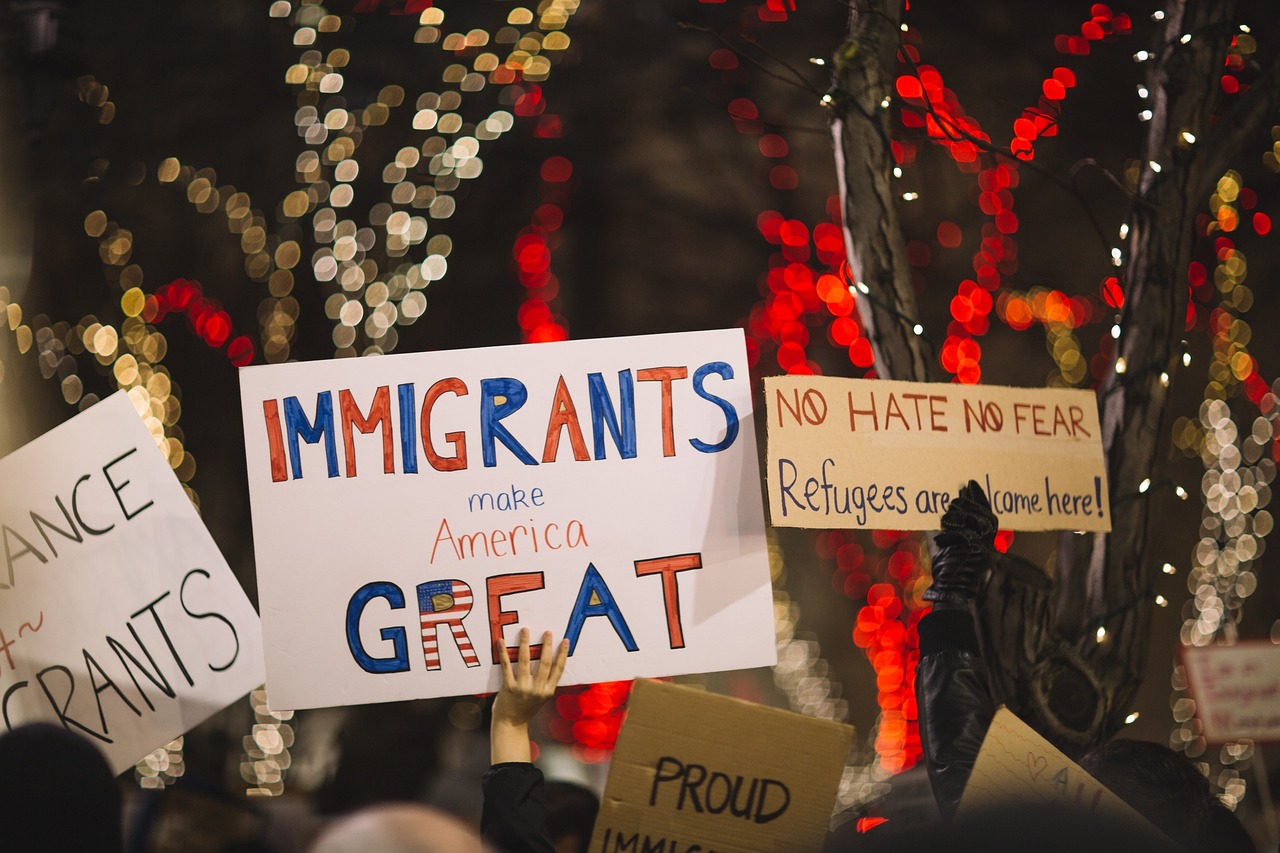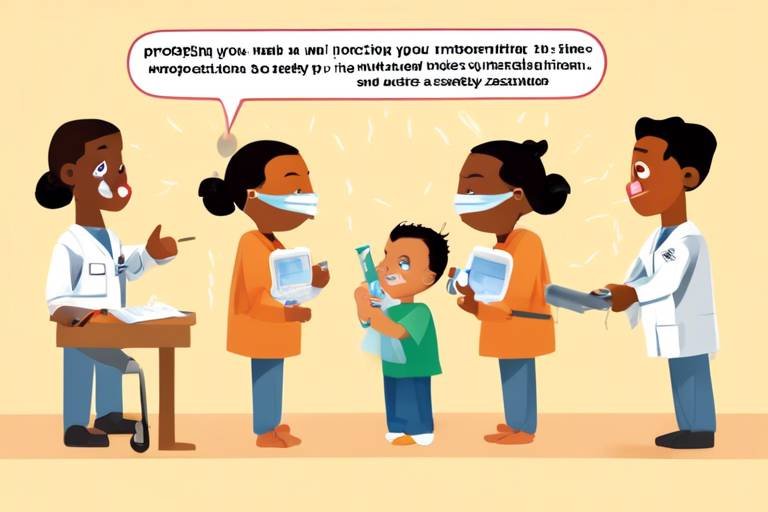Talking about Safety Issues Faced by Immigrants
Immigrants are often seen as the backbone of many economies, contributing their skills and hard work to build communities. However, beneath the surface of this contribution lies a myriad of safety challenges that can severely impact their lives. From facing discrimination and harassment to grappling with language barriers and limited access to essential resources, the journey of an immigrant can be fraught with peril. This article aims to shed light on these pressing issues while also exploring potential solutions and support systems available to help immigrants navigate their unique safety challenges.
The safety issues faced by immigrants are not just abstract concepts; they are lived experiences that can lead to significant emotional and psychological distress. Imagine moving to a new country, full of hope and dreams, only to find yourself in a situation where your safety is constantly at risk. This reality is all too common for many immigrants, who often feel isolated and vulnerable in their new environments. Understanding these challenges is the first step toward creating a safer and more inclusive society.
In the following sections, we will delve deeper into specific safety issues, including the impact of discrimination and harassment, the importance of community support systems, and the barriers to accessing healthcare. We will also examine how legal status can affect safety and the fear of deportation that looms over many undocumented immigrants. By highlighting these issues, we hope to foster a greater understanding of the immigrant experience and encourage dialogue around potential solutions.
- What are the main safety issues faced by immigrants? Immigrants often face discrimination, language barriers, lack of access to healthcare, and fear of deportation, which can all compromise their safety.
- How can community organizations help immigrants? Community organizations provide essential resources, support networks, and advocacy for immigrants, helping them navigate challenges and feel secure in their new environments.
- What legal protections exist for immigrant workers? Various labor laws are designed to protect all workers, including immigrants, from exploitation and unsafe working conditions. Understanding these laws can empower immigrants to advocate for their rights.
- How can language barriers affect access to healthcare? Language barriers can lead to miscommunication between healthcare providers and immigrants, making it difficult for them to receive appropriate care. Solutions include providing interpreters and bilingual resources.
- What can be done to improve safety for undocumented immigrants? Advocacy for comprehensive immigration reform, as well as community support and education, can enhance safety for all immigrants, regardless of their legal status.

Understanding Immigrant Vulnerability
Immigrants often find themselves navigating a complex web of challenges that can significantly impact their safety and well-being. These challenges stem from a variety of factors that contribute to their vulnerability. For starters, many immigrants arrive in a new country with limited financial resources, which can lead to precarious living conditions. Imagine stepping into a new world where everything feels foreign, and the safety nets you once relied on are nowhere to be found. This situation can create a sense of instability that is hard to shake off.
Another critical factor is the legal uncertainty that many immigrants face. Whether they are undocumented or in the process of obtaining legal status, the fear of deportation looms large. This fear can prevent individuals from seeking help, whether it be from law enforcement or social services, making them easy targets for exploitation. It's like walking a tightrope without a safety net, where one misstep could lead to dire consequences.
Socioeconomic status plays a significant role in this vulnerability. Many immigrants are forced to take low-wage jobs that offer little to no security or benefits. This lack of economic stability not only affects their ability to provide for their families but also limits their access to essential resources like healthcare and legal assistance. The cycle of poverty can be relentless, trapping them in a situation where they feel powerless and alone.
Moreover, language barriers can exacerbate these vulnerabilities. Communication is key in any society, and when you can't express your needs or understand your rights, it becomes incredibly challenging to navigate everyday life. For instance, an immigrant trying to report a crime may struggle to communicate effectively with law enforcement, leading to feelings of frustration and helplessness. Imagine trying to shout for help but finding that no one understands your language—it's a daunting experience.
In summary, the vulnerabilities faced by immigrants are multifaceted and deeply rooted in their socioeconomic, legal, and cultural contexts. Understanding these challenges is the first step toward creating a more inclusive and supportive environment for immigrants. By acknowledging their struggles, we can begin to dismantle the barriers that prevent them from feeling safe and secure in their new homes.

Discrimination and Harassment
Discrimination remains a significant safety issue for immigrants, manifesting in various forms that can severely impact their daily lives and overall well-being. Imagine moving to a new country, filled with hope and dreams, only to be met with hostility and prejudice. This is the harsh reality for many immigrants who face discrimination in public spaces, workplaces, and even within their communities. The implications of such treatment can be devastating, leading to feelings of isolation, anxiety, and a sense of powerlessness.
In public spaces, immigrants may encounter verbal abuse, racial profiling, or even physical harassment. Such experiences not only threaten their physical safety but also their mental health. The constant fear of being targeted can lead to a withdrawal from community interactions, which further exacerbates their vulnerability. In workplaces, the situation can be even more precarious. Many immigrants find themselves in low-wage jobs, where they are susceptible to exploitative practices. They might face unfair treatment, such as being assigned the most dangerous tasks without proper safety measures, all due to their status as newcomers.
To illustrate the prevalence of discrimination, consider the following statistics:
| Type of Discrimination | Percentage of Immigrants Affected |
|---|---|
| Workplace Discrimination | 40% |
| Verbal Harassment | 30% |
| Physical Assault | 10% |
As we can see, discrimination is not just a minor inconvenience; it is a pervasive issue that can lead to serious safety concerns for immigrants. The implications extend beyond the immediate effects of harassment. They can lead to long-term psychological trauma, which can affect an individual's ability to integrate into society and contribute economically. The fear of discrimination can also deter immigrants from seeking help or reporting incidents, creating a cycle of silence and suffering.
Moreover, the impact of discrimination is not felt in isolation. It ripples through families and communities, affecting everyone involved. Children of immigrants, for instance, may experience bullying in schools, which can hinder their educational achievements and social development. This creates an environment where the cycle of discrimination continues, as these children grow up with the same fears and prejudices that their parents faced.
To combat these issues, it is essential to foster a culture of understanding and support. Community organizations play a vital role in providing resources and advocacy for immigrants facing discrimination. They offer safe spaces for individuals to share their experiences and seek help. Additionally, educational programs aimed at raising awareness about the challenges faced by immigrants can help bridge the gap between communities and promote inclusivity.
In conclusion, discrimination and harassment pose significant safety challenges for immigrants. Acknowledging these issues is the first step toward creating a more equitable society. By advocating for change and supporting one another, we can work towards a world where everyone, regardless of their background, can feel safe and valued.
- What should I do if I experience discrimination? If you experience discrimination, it is important to document the incident and seek support from community organizations or legal aid services.
- How can communities help immigrants facing discrimination? Communities can help by offering resources, education, and advocacy to raise awareness about discrimination and support affected individuals.
- Are there legal protections against discrimination for immigrants? Yes, many countries have laws that protect individuals from discrimination based on race, nationality, and other factors, but enforcement can vary.

Workplace Safety Concerns
When it comes to workplace safety, immigrants often find themselves in precarious situations that can lead to serious risks and exploitation. Many immigrants take on jobs that are physically demanding and sometimes hazardous, often due to a lack of options or resources. Imagine being in a new country, trying to make a living, and having to accept a job that puts your health on the line simply because you feel you have no other choice. This is a harsh reality for many, and it's crucial to understand the factors that contribute to these unsafe conditions.
One significant issue is the lack of proper safety training. Many immigrants may not receive adequate training on workplace safety protocols, which can lead to accidents and injuries. For instance, workers in construction or manufacturing might not be informed about the proper use of safety equipment or how to handle hazardous materials. This lack of information not only puts their lives at risk but can also affect their productivity and job security.
Additionally, immigrants often work in environments where exploitation is rampant. Employers may take advantage of their vulnerable status, offering lower wages and demanding longer hours without appropriate compensation. This exploitation is not just a financial burden; it can lead to physical and mental exhaustion, making it even harder for these individuals to voice their concerns about unsafe working conditions. Many feel trapped, fearing that speaking up could lead to job loss, deportation, or other severe consequences.
Furthermore, the absence of effective legal protections exacerbates these safety concerns. While there are laws in place designed to protect all workers, many immigrants are either unaware of their rights or feel intimidated to assert them. This lack of awareness can create a cycle of fear and vulnerability, where workers remain silent about unsafe practices. To illustrate this, consider the following table that outlines common safety risks faced by immigrants in the workplace:
| Type of Risk | Description |
|---|---|
| Physical Hazards | Inadequate safety equipment leading to injuries. |
| Psychological Hazards | Stress and anxiety from job insecurity and exploitation. |
| Legal Risks | Fear of retaliation for reporting unsafe conditions. |
It's essential to recognize that workplace safety is not just a personal issue for immigrants; it affects entire communities. When immigrant workers are subjected to unsafe conditions, it can lead to broader societal implications, such as increased healthcare costs and reduced economic productivity. Therefore, addressing these safety concerns is not only a matter of justice but also a necessity for fostering a healthier and more equitable society.
In conclusion, the challenges faced by immigrants in the workplace regarding safety are multifaceted and deeply rooted in systemic issues. By raising awareness and advocating for better protections, we can help create safer work environments for everyone. This change starts with community support, education, and a commitment to standing up against exploitation and unsafe practices.

Legal Protections for Workers
Understanding the legal protections available to workers is crucial for immigrants who often find themselves in precarious employment situations. Many immigrants may not be aware of their rights, which can leave them vulnerable to exploitation and unsafe working conditions. In the United States, various laws are designed to protect all workers, regardless of their immigration status. These laws encompass not only basic workplace safety but also fair wages, anti-discrimination measures, and the right to organize.
For instance, the Occupational Safety and Health Administration (OSHA) sets forth regulations that require employers to provide a safe working environment. This means that workers have the right to report unsafe conditions without fear of retaliation. Moreover, the Fair Labor Standards Act (FLSA) ensures that all workers receive at least the federal minimum wage and are entitled to overtime pay. Understanding these protections can empower immigrants to advocate for their rights and seek help when necessary.
However, many immigrants may feel hesitant to assert these rights due to fears of repercussions, especially if they are undocumented. To combat this, community organizations often provide resources and legal assistance to help workers navigate these complex laws. For example, some organizations offer workshops and informational sessions that explain workers' rights in a language that immigrants can understand, thereby breaking down the language barrier that often complicates these issues.
It's also essential for immigrants to know how to report violations safely. Many states have hotlines and online platforms where workers can report unsafe conditions or discrimination anonymously. This anonymity can provide a layer of protection for those who fear retaliation from their employers. By utilizing these resources, immigrants can take proactive steps to ensure their safety and well-being in the workplace.
In summary, while the legal landscape can be daunting for immigrant workers, knowledge is power. By understanding their rights and the protections available to them, immigrants can better navigate the challenges they face in the workforce. Community support and advocacy play a pivotal role in ensuring that these workers are not only aware of their rights but also empowered to exercise them.
- What are the basic rights of immigrant workers?
Immigrant workers have the right to a safe workplace, fair wages, and protection against discrimination, regardless of their immigration status. - How can immigrants report unsafe working conditions?
Immigrants can report unsafe conditions through state hotlines or OSHA, often anonymously to protect their identity. - Are undocumented workers protected by labor laws?
Yes, undocumented workers are entitled to the same protections under labor laws as documented workers, including the right to safe working conditions and fair pay.

Reporting Mechanisms
When it comes to ensuring safety in the workplace, having effective is crucial for immigrants. Many individuals find themselves in precarious situations where they face discrimination or unsafe working conditions, yet they may hesitate to report these issues due to fear of retaliation or lack of knowledge about their rights. It's essential to understand that there are avenues available for immigrants to voice their concerns without putting themselves at further risk.
One of the primary challenges immigrants face is the uncertainty surrounding the reporting process. Many are unaware of their rights or feel that their legal status may jeopardize their ability to seek help. This fear can create a cycle of silence, where unsafe practices continue unchecked. However, community organizations and legal aid groups are stepping up to provide vital resources and information. These organizations often offer confidential hotlines and support systems that can help immigrants navigate the complexities of reporting workplace issues.
Additionally, many workplaces are required to have clear reporting procedures in place. This includes designated personnel to handle complaints and a structured process for addressing grievances. Immigrants should be encouraged to familiarize themselves with these protocols. For instance, if an immigrant experiences harassment or unsafe conditions, they can document the incidents and report them to their human resources department or a trusted supervisor. It's important to note that employers are legally obligated to investigate these claims thoroughly.
To further empower immigrants, community organizations often conduct workshops that educate them about their rights and the reporting mechanisms available. These sessions can demystify the process and provide practical steps for individuals to take when they feel unsafe. By creating a supportive environment, immigrants can gain the confidence to speak up about their experiences.
Moreover, many cities and states have established whistleblower protections that safeguard individuals who report unsafe conditions or discrimination. These laws are designed to ensure that employees cannot be retaliated against for voicing their concerns. Understanding these protections can be a game-changer for immigrants who fear losing their jobs or facing deportation. It’s a reminder that they are not alone and that there are legal frameworks in place to support them.
In summary, effective reporting mechanisms are essential for immigrant safety in the workplace. By utilizing community resources, understanding workplace protocols, and knowing their rights, immigrants can take proactive steps to ensure their safety and well-being. The journey may seem daunting, but with the right support and information, they can navigate these challenges successfully.
- What should I do if I experience discrimination at work?
If you face discrimination, document the incidents and report them to your HR department or a trusted supervisor. You can also seek support from community organizations that specialize in workers' rights.
- Are there protections for immigrants who report unsafe working conditions?
Yes, many states have whistleblower protections that prevent retaliation against individuals who report unsafe conditions or discrimination.
- How can community organizations help me?
Community organizations can provide resources, legal assistance, and workshops to educate immigrants about their rights and the reporting process.

Community Support Systems
Community support systems are lifelines for immigrants, offering not just resources but also a sense of belonging in a new land. Imagine stepping into a foreign place where everything feels unfamiliar—the language, the customs, and even the people. In such situations, having a community that understands your struggles can be a game-changer. These networks provide essential services that help immigrants navigate their new environments, ensuring they feel safe and supported.
Many community organizations focus on various aspects of immigrant life, including legal assistance, job training, and social services. For instance, local non-profits often host workshops that teach immigrants about their rights, helping them to understand the legal frameworks that protect them. This knowledge is crucial, as it empowers individuals to stand up against discrimination and exploitation. Furthermore, these organizations provide a platform for immigrants to share their experiences and learn from one another, fostering a strong sense of community.
One of the most impactful ways community support systems operate is through mentorship programs. These programs pair newcomers with established members of the community who can guide them through the challenges of acclimating to a new culture. Mentors can offer practical advice on everything from finding a job to accessing healthcare, making the transition smoother and less intimidating.
Additionally, many communities organize social events that celebrate cultural diversity. These events not only provide a space for immigrants to connect with one another but also allow them to share their traditions with the broader community. This exchange fosters understanding and acceptance, breaking down barriers and reducing discrimination. It’s like adding colors to a painting; each community adds its unique hue, creating a vibrant tapestry of cultures.
Moreover, community support systems often collaborate with local governments and organizations to advocate for policies that benefit immigrants. This advocacy is crucial in creating safer environments and ensuring that immigrants' voices are heard. By working together, communities can push for changes that address systemic issues, such as access to healthcare, housing, and education.
In summary, community support systems are essential for the safety and well-being of immigrants. They not only provide resources but also create a sense of belonging and empowerment. By fostering strong networks, immigrants can navigate their new lives with greater confidence and security.
- What types of services do community support systems offer for immigrants?
Community support systems provide various services, including legal assistance, job training, language classes, and social activities to help immigrants integrate into their new environment. - How can I find a community support organization near me?
You can search online for local non-profits, community centers, or immigrant advocacy groups. Many cities have directories that list resources available to immigrants. - Can community support systems help with legal issues?
Yes, many community organizations offer legal assistance or can connect you with legal professionals who specialize in immigration law. - Are there mentorship programs available for immigrants?
Yes, many community support organizations offer mentorship programs that pair newcomers with established community members to help them navigate challenges.

Access to Healthcare Services
Access to healthcare is a critical safety issue for immigrants, who often find themselves navigating a complex web of barriers that can jeopardize their health and well-being. Imagine being in a new country, surrounded by unfamiliar customs and languages, and then facing the daunting task of obtaining medical care. For many immigrants, this is not just a challenge; it’s a significant source of stress that can lead to worsening health conditions. The barriers they encounter can range from financial limitations to a lack of understanding of the healthcare system, creating a perfect storm of challenges that can leave them feeling vulnerable and unsupported.
One of the primary barriers is financial constraints. Many immigrants work in low-paying jobs that do not provide health insurance, making it difficult to afford even basic medical care. According to recent studies, a significant percentage of immigrants are uninsured, which not only affects their ability to seek immediate care but also discourages them from preventive measures. This lack of access can lead to serious health issues down the line, as minor ailments go untreated and develop into more severe conditions.
Additionally, cultural differences can play a huge role in healthcare access. Many immigrants come from cultures where seeking medical help is not the norm, or where alternative medicine is preferred. This can create a disconnect when they finally do seek help, as they may not fully understand the medical practices or terminology used in their new environment. Furthermore, the fear of being judged or misunderstood can prevent them from expressing their health concerns accurately, leading to misdiagnoses or inadequate treatment.
Language barriers are another significant hurdle. When healthcare providers and patients do not share a common language, it can lead to serious misunderstandings. For instance, a patient may struggle to explain their symptoms, or a doctor might misinterpret a patient's needs. In many cases, this results in immigrants either avoiding medical care altogether or receiving inadequate treatment. To combat this, some healthcare facilities are beginning to offer translation services, but these are still not universally available.
Many immigrant communities have started to organize their own health education programs, which can be a beacon of hope. These programs often aim to educate individuals about their health rights and available services, helping bridge the gap between immigrants and the healthcare system. By fostering a sense of community and support, these initiatives empower immigrants to take charge of their health. In fact, studies show that when immigrants are informed about their rights and available resources, they are more likely to seek medical care.
In summary, while the challenges immigrants face in accessing healthcare services are significant, there are pathways to improve this situation. Increased community support, better translation services, and comprehensive health education can make a world of difference. By addressing these barriers, we can ensure that immigrants not only feel safe but also receive the care they deserve.
- What are the main barriers immigrants face in accessing healthcare? Financial constraints, language barriers, and cultural differences are some of the primary challenges that hinder access to healthcare for immigrants.
- How can community organizations help immigrants with healthcare access? Community organizations can provide health education, resources, and support systems that empower immigrants to navigate the healthcare system more effectively.
- Are there any legal protections for immigrants regarding healthcare? Yes, many countries have laws that protect the rights of immigrants to access healthcare services, regardless of their legal status.

Language Barriers in Healthcare
Language barriers in healthcare can create significant challenges for immigrants seeking medical care. Imagine walking into a doctor's office where every sign, every conversation, and every instruction is in a language you don’t understand. It’s like trying to navigate a maze blindfolded! This situation can lead to misunderstandings, misdiagnoses, and ultimately, inadequate care. Immigrants often come from diverse linguistic backgrounds, and the inability to communicate effectively with healthcare providers can have dire consequences for their health and safety.
One of the most pressing issues is that many healthcare facilities lack multilingual staff or interpreters. According to a study by the National Health Law Program, nearly 25% of patients with limited English proficiency reported not receiving the medical care they needed due to communication barriers. This statistic highlights the urgent need for healthcare systems to implement better resources to accommodate non-English speakers. Without proper interpretation services, immigrants may not fully understand their diagnoses, treatment options, or even medication instructions.
Moreover, language barriers can also contribute to a lack of trust in healthcare providers. When patients feel that their concerns are not being understood, they may hesitate to seek help in the future. This cycle of avoidance can lead to worsening health conditions, as preventive care and early interventions are often sidelined. It’s essential for healthcare providers to foster an environment where patients feel safe and understood, regardless of their language skills.
To combat these issues, many organizations are advocating for the implementation of language access policies in healthcare settings. These policies can include:
- Providing professional interpreters for patients who need them.
- Training staff on cultural competency and the importance of effective communication.
- Utilizing technology, such as translation apps, to facilitate communication.
Additionally, community health programs are stepping up to offer language assistance and education. These programs can serve as a bridge, helping immigrants navigate the healthcare system while ensuring they receive the care they need. By empowering immigrants with the knowledge of their health rights and available resources, we can create a safer and more inclusive healthcare environment.
Q: What can I do if I face language barriers in healthcare?
A: If you encounter language barriers, request an interpreter when making your appointment. Many healthcare facilities are required to provide language assistance. You can also bring a family member or friend who speaks both languages to help translate.
Q: Are there resources available for immigrants to learn about their health rights?
A: Yes! Many community organizations offer workshops and resources to educate immigrants about their health rights, available services, and how to navigate the healthcare system effectively.
Q: How can healthcare providers improve communication with non-English speakers?
A: Healthcare providers can improve communication by hiring multilingual staff, providing interpreter services, and utilizing visual aids or technology to help convey important information.

Health Education and Resources
Providing health education is essential for immigrant communities, as it empowers individuals to make informed decisions about their health and well-being. Many immigrants arrive in a new country with limited knowledge about the healthcare system, which can lead to misunderstandings and missed opportunities for care. It's crucial to bridge this gap by offering accessible resources that cater to their unique needs. Various organizations and community groups are stepping up to fill this void, offering workshops, informational sessions, and printed materials in multiple languages.
One of the most effective ways to disseminate health information is through community health fairs. These events not only provide valuable health screenings but also serve as a platform for education on topics such as nutrition, mental health, and preventive care. For instance, a community health fair might include:
- Free blood pressure and diabetes screenings
- Workshops on healthy eating and exercise
- Information on local healthcare services and how to access them
- Resources about mental health support and counseling
Furthermore, partnerships between local health departments and immigrant organizations can enhance the reach of health education initiatives. By working together, these entities can develop tailored programs that address the specific health concerns prevalent in immigrant populations. For example, they might focus on issues such as maternal health, chronic diseases, or mental health challenges that are often overlooked.
Language barriers can pose a significant challenge in accessing health education. To combat this, it's important to provide materials in various languages and utilize bilingual staff during health education sessions. This approach not only fosters better understanding but also builds trust within the community. Additionally, utilizing technology, such as mobile apps and websites, can offer immigrants the ability to access health information at their convenience, further enhancing their understanding of available resources.
Ultimately, empowering immigrants through health education is about more than just providing information; it’s about creating a supportive environment where they feel safe to ask questions and seek help. By equipping them with knowledge and resources, we can help to ensure that they are not only informed but also able to advocate for their health and the health of their families.
Q1: What types of health education programs are available for immigrants?
A1: Various programs are available, including workshops on nutrition, mental health resources, and preventive care screenings. Many community organizations offer tailored sessions to meet specific needs.
Q2: How can immigrants find healthcare services in their area?
A2: Immigrants can find healthcare services through local health departments, community health centers, and immigrant support organizations that often provide resources and referrals.
Q3: Are there resources available in multiple languages?
A3: Yes, many health education materials and services are available in multiple languages to ensure accessibility for non-English speakers.
Q4: How can community organizations help improve health education for immigrants?
A4: Community organizations can help by organizing health fairs, providing bilingual resources, and creating partnerships with local health departments to offer tailored programs that address specific health concerns.

Legal Status and Safety
The legal status of immigrants plays a pivotal role in their overall safety and security. For many, the distinction between being documented or undocumented can mean the difference between access to basic rights and living in constant fear. Undocumented immigrants often find themselves in precarious situations, where the threat of deportation looms large, creating a chilling effect that discourages them from seeking help or reporting unsafe conditions. Imagine living in a house where the walls are closing in on you; that’s how it feels for those without legal status, trapped and vulnerable.
One of the most pressing issues faced by undocumented immigrants is the fear of exploitation. Without legal protections, they are often at the mercy of employers who may take advantage of their situation. This could manifest in various forms, including unfair wages, unsafe working conditions, and even emotional and physical abuse. The lack of legal recourse can lead to a cycle of abuse that is hard to escape. For instance, if an undocumented worker is injured on the job, they may hesitate to seek medical attention due to fears of being reported to immigration authorities.
Moreover, the fear of law enforcement is another significant aspect of safety for immigrants with uncertain legal status. Many undocumented individuals avoid interactions with police, even in situations where they are victims of crimes. This avoidance can lead to a heightened risk of victimization, as they feel they have no safe avenue for reporting crimes or seeking justice. It’s like being in a maze with no exit; the walls are high, and every turn feels risky.
To better understand the implications of legal status on safety, consider the following table:
| Legal Status | Safety Implications |
|---|---|
| Documented | Access to legal protections, healthcare, and reporting mechanisms. |
| Undocumented | Increased risk of exploitation, fear of deportation, reluctance to report crimes. |
Advocacy for comprehensive immigration reform is essential in addressing these safety concerns. By pushing for policies that protect all immigrants, regardless of their legal status, we can foster a safer environment for everyone. Communities can play a significant role in this advocacy, supporting policies that promote fair treatment and inclusivity. When immigrants feel secure in their legal standing, they are more likely to contribute positively to their communities, enriching the social fabric.
In conclusion, the link between legal status and safety cannot be overstated. It’s crucial for immigrants to have access to resources, support systems, and legal protections that empower them to live without fear. By addressing these issues, we can create a society that values safety and dignity for all individuals, regardless of their immigration status.
- What are the main safety concerns for undocumented immigrants? Undocumented immigrants often face exploitation, fear of deportation, and reluctance to report crimes.
- How can legal status affect access to healthcare? Undocumented immigrants may avoid seeking medical care due to fear of being reported, leading to untreated health issues.
- What role do community organizations play in supporting immigrants? Community organizations provide resources, advocacy, and a sense of belonging, helping immigrants navigate safety challenges.
- How can individuals advocate for immigrant safety? Individuals can support policies that promote fair treatment and inclusivity for all immigrants, regardless of their legal status.

Fear of Deportation
The is a shadow that looms over many immigrants, creating a chilling effect on their daily lives. This fear is not just a minor inconvenience; it can be a crippling barrier that prevents individuals from seeking help, reporting crimes, or even accessing essential services. Imagine living in a constant state of anxiety, where every interaction with law enforcement could potentially lead to the separation from family and the life you’ve built. It’s a reality that many immigrants face, and it can have profound psychological effects.
When individuals are undocumented, they often feel trapped in a cycle of silence and fear. This fear is exacerbated by stories of families being torn apart and communities being shattered by sudden raids. The implications of this fear are significant. For instance, many immigrants may refrain from reporting incidents of domestic violence or workplace exploitation because they worry that seeking assistance could lead to their deportation. This creates a dangerous environment where abusers and exploiters can operate with impunity.
Furthermore, the fear of deportation can also lead to a decline in mental health. Stress, anxiety, and depression are common among immigrants who live under the constant threat of being removed from their homes. They may feel isolated, lacking the support systems that are crucial for mental well-being. The stigma surrounding undocumented status can also prevent them from reaching out for help, further entrenching their feelings of despair.
To illustrate the impact of this fear, consider the following statistics:
| Statistic | Percentage |
|---|---|
| Undocumented immigrants who avoid seeking medical care | 40% |
| Victims of crime who do not report incidents due to fear | 60% |
| Immigrants who experience anxiety and depression | 55% |
These numbers highlight just how pervasive the fear of deportation can be. It’s not just a personal issue; it’s a societal one that affects community safety and cohesion. When individuals are afraid to come forward, it creates dangerous gaps in our social fabric, allowing crime to flourish and individuals to suffer in silence.
So, what can be done to alleviate this fear? Advocacy is key. Communities can come together to create safe spaces where immigrants feel secure and supported. Local organizations can provide resources and information about rights and protections, helping to empower individuals to seek help without fear. Additionally, comprehensive immigration reform is crucial in addressing the root causes of this fear. By creating pathways to legal status, we can reduce the anxiety surrounding deportation and foster a more inclusive society.
In conclusion, the fear of deportation is a significant safety issue for immigrants that permeates many aspects of their lives. By understanding and addressing this fear, we can work towards a society where everyone feels safe and secure, regardless of their immigration status.
- What can immigrants do if they fear deportation? Immigrants can seek legal counsel and connect with community organizations that offer resources and support.
- How can communities help reduce the fear of deportation? Communities can create safe spaces and provide education about rights and protections available to immigrants.
- What are the psychological effects of the fear of deportation? Many immigrants experience anxiety, depression, and social isolation due to the constant threat of deportation.

Advocacy for Immigration Reform
Advocating for comprehensive immigration reform is not just a political issue; it’s a matter of human rights and safety for millions of immigrants. The current immigration system often leaves many individuals vulnerable to exploitation, discrimination, and fear. By pushing for reform, we can create a safer environment that allows immigrants to thrive rather than just survive. So, what does this reform entail, and why is it so crucial?
First and foremost, immigration reform aims to address the legal status of undocumented immigrants. Many of these individuals live in constant fear of deportation, which can prevent them from seeking help in unsafe situations or reporting crimes. This fear creates a cycle of insecurity that not only affects them but also their families and communities. By providing a pathway to legal status, we can help immigrants feel secure enough to engage with law enforcement and access essential services without the looming threat of being torn away from their loved ones.
Moreover, advocating for reform means fighting for fair labor practices. Many immigrants work in industries that often exploit their vulnerable status, leading to unsafe working conditions and unfair wages. By reforming labor laws and ensuring that they are enforced, we can protect immigrant workers from abuse and create a more equitable workforce. This is not just beneficial for immigrants; it elevates the standards for everyone, fostering a healthier economy.
Community involvement is also a key aspect of immigration reform advocacy. Local organizations and grassroots movements play a vital role in raising awareness and mobilizing support for policy changes. These groups often serve as a lifeline for immigrants, providing resources, education, and a sense of community. For instance, they can organize workshops to educate immigrants about their rights or hold rallies to push for legislative changes. When communities come together, their collective voice can be a powerful force for change.
To effectively advocate for immigration reform, it’s essential to engage with policymakers and the public. This can be achieved through:
- Lobbying: Meeting with legislators to discuss the importance of reform and the benefits it brings to society.
- Public Awareness Campaigns: Utilizing social media, community events, and educational programs to inform the public about the realities immigrants face.
- Building Alliances: Collaborating with other advocacy groups, labor unions, and community organizations to strengthen the movement.
In conclusion, advocating for immigration reform is essential for enhancing the safety and well-being of immigrants. It requires a concerted effort from individuals, communities, and organizations to push for changes that will create a safer, more just society for all. As we continue to fight for these reforms, let’s remember that every voice matters, and together, we can make a difference.
As we wrap up this section, it’s important to consider the broader implications of immigration reform. By ensuring that all individuals have access to legal protections, fair wages, and safe working conditions, we not only uplift immigrant communities but also strengthen our society as a whole. So, what steps will you take to advocate for change?
Q: What is immigration reform?
A: Immigration reform refers to changes in laws and policies that govern immigration, aimed at addressing issues such as undocumented status, labor rights, and pathways to citizenship.
Q: Why is advocacy important?
A: Advocacy raises awareness about the challenges immigrants face and mobilizes support for policy changes that can enhance their safety and well-being.
Q: How can I get involved in advocacy efforts?
A: You can get involved by joining local organizations, participating in community events, and contacting your legislators to express your support for immigration reform.
Frequently Asked Questions
- What are the main safety issues faced by immigrants?
Immigrants encounter a variety of safety issues, including discrimination, language barriers, and limited access to essential resources. These challenges can significantly impact their well-being and security in their new environment.
- How does discrimination affect immigrants?
Discrimination can lead to feelings of isolation and fear among immigrants. It manifests in various forms, from verbal harassment in public spaces to unfair treatment in workplaces, which can harm their mental and emotional health.
- What legal protections are available for immigrant workers?
There are several labor laws designed to protect workers, including immigrants. These laws ensure fair treatment, safe working conditions, and the right to report unsafe practices without fear of retaliation.
- How can immigrants report workplace safety issues?
Immigrants can report safety concerns through various channels, such as workplace safety hotlines, community organizations, or legal aid services. It's essential to ensure these reports are made confidentially to avoid retaliation.
- What role do community organizations play in supporting immigrants?
Community organizations provide critical resources, advocacy, and support networks that help immigrants navigate safety challenges. They foster a sense of belonging and security, making it easier for immigrants to access necessary services.
- What barriers do immigrants face in accessing healthcare?
Language barriers, lack of insurance, and fear of discrimination often prevent immigrants from seeking medical care. These obstacles can lead to significant health risks and a lower quality of life.
- How can language barriers in healthcare be addressed?
Improving communication in medical settings can involve hiring bilingual staff, providing translation services, and creating educational materials in multiple languages to ensure immigrants understand their health rights and available services.
- Why does legal status impact immigrant safety?
Undocumented immigrants often live in fear of deportation, which can deter them from seeking help in unsafe situations. This fear can lead to exploitation and increased vulnerability to various safety issues.
- What can be done to advocate for immigrant safety?
Advocating for comprehensive immigration reform and supporting local organizations can enhance safety for all immigrants. Community involvement and policy changes are crucial in creating safer environments for immigrant populations.



















